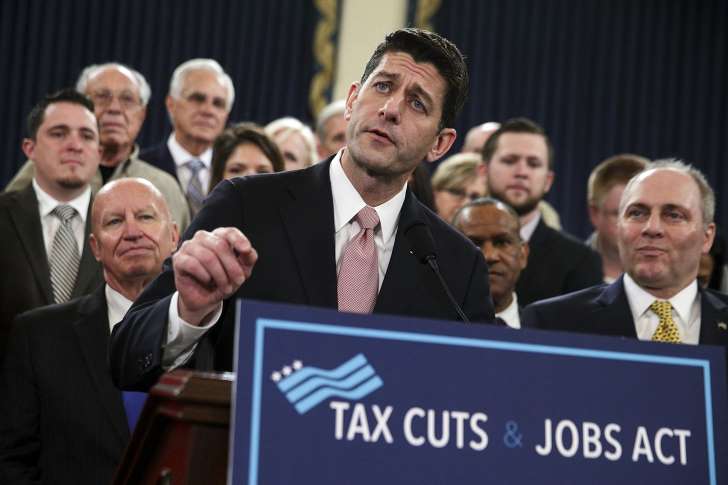
?Alex Wong/Getty Images U.S. Speaker of the House Rep. Paul Ryan (R-WI) (C) speaks as Chairman of House Ways and Means Committee Rep. Kevin Brady (R-TX) (L) and House Majority Whip Rep Steve Scalise (R-LA) (R) listen during a news President Trump promised to cut taxes for the middle class, but some would end up paying more under the ”Tax Cuts and Jobs Act,” according to a report released Friday night by Congress’s Joint Committee on Taxation, the official scorekeepers tasked with determining how much any tax legislation would add to the debt and how it would impact the poor, middle class and wealthy.
The Trump administration says it has a ”bright line test”that the president won’t support any tax bill that does not give the middle class relief on their taxes. The ”Tax Cuts And Jobs Act”that House Republicans released Thursday appears to violate that vow, at least for some middle-class taxpayers.
The JCT found that the GOP bill would add nearly $1.5 trillion to the debt over the next decade and that, on average, families earning between $20,000 and $40,000 a year and between $200,000 to $500,000 would pay more in individual income taxes in 2023 and beyond.
Subscribe to the Post Most newsletter: Today most popular stories on The Washington Post
JCT does not explain why these families see an increase, but it is likely that it’s in part because some tax credits aimed at helping the middle class expire in 2023, including the Family Flexibility Credit. Republicans are currently debating whether to extend this credit, but that would require revenue from somewhere else. Some are banking on Congress not allowing the credit to expire when the time comes. Upper middle-class families are also losing popular tax breaks like the state and local income tax (SALT) deduction, which may explain why they get higher tax bills.
It’s possible that other families will also see their tax bills jump under the plan. JCT only reports what happens to the average taxpayer in each income bracket. Experts across the political spectrum, including the Tax Policy Center, plan to release more detailed reports in the coming days showing what happens to large and small families, rich and poor, and those that claim big medical deductions under the GOP plan.
House Republicans argue that the JCT analysis undercounts the benefits to the middle class.
”The purpose of tax reform isn”t just to lower taxes for struggling families it’s also to make our economy boom again,” said the Republican-led House Ways and Means Committee in a statement Saturday. ”Unfortunately, JCT抯 analysis omits the economic effects of tax reform in their distributional tables. This means that the JCT analysis misses the bigger picture.”
But Democratic tax experts say most of the benefits go to the richest Americans.
”JCT estimates show that this bill is heavily tilted toward the wealthy,”says Lily Batchelder, a tax law professor at New York University and former member of President Obama’s National Economic Council.
Batchhelder used the JCT analysis to look at who gets the biggest income boost from the GOP plan. She found that millionaires would see their after-tax incomes rise by 2.2 percent after a decade, and that is without factoring in how wealthy families benefit for the elimination of the estate tax. Families earning $50,000 to $70,000 ?the middle of the middle ?would see only a 0.6 percent rise, and families earning $20,000 to $40,000 get no benefit.
打开微信扫一扫
点击右上角分享
此文章到朋友圈




